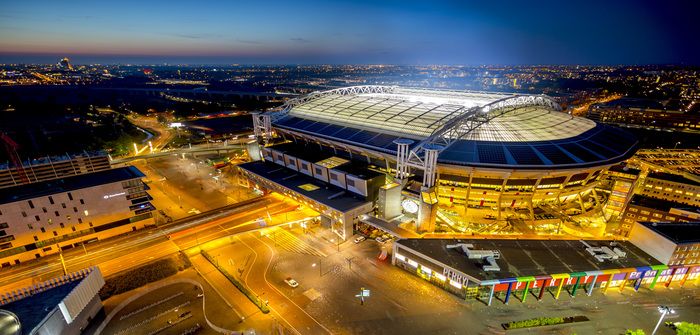From 360° video walls to microbreweries and Michelin-star restaurants – the way sports stadia are designed, built, run and managed has evolved rapidly. No longer can arenas be concrete shells that solely encapsulate thousands of fans for 25 home games a year. To be successful in the modern era, they must adapt, support the finances of the club, and become multipurpose powerhouses that stimulate the local economy and excite spectators in the stands and at home.
Lighting, once the most overlooked aspect of arena design, is now leading the way stadia are redefining themselves. So how has this humble utility become a catalyst for change and how can stadium operators use it to improve the commercial viability of their arenas? And importantly, how will it shape the next step in the stadium experience?
Power of TV
The demand for high-quality TV coverage for sports has seen a reciprocal raising of the bar in broadcast standards, codified by international sports federations and independent broadcasters. HDTV, 3D and now ultra-high definition TV (4K) provide a more immersive viewing experience where crisp footage and slow-motion replays capture every detail – from a player’s emotions, gestures and actions, to individual drops of rain.
Going hand-in-hand with new broadcast standards are more stringent pitch lighting standards. The metal halide floodlights of yesteryear, which can cause TV flicker, fall short of the high performance required by 4K television cameras. To be compliant, stadia are increasingly shifting to LED lighting which is becoming the de facto standard for stadia competing to host the most coveted international tournaments.
Pitch lighting is just the tip of the iceberg. Few top-flight stadia can afford to be mono-sports facilities and have embraced a multipurpose arena model. Key to this is next-generation lighting technology (such as Philips ArenaVision LED), which is enabling top European soccer clubs such as Ajax, Atletico Madrid, Juventus and Olympique Lyonnais to heighten their fan experience through customizable light shows.
Unlike conventional lighting, new LED systems can be monitored, controlled, rapidly switched, dimmed and synced to music, jumbotrons and perimeter boards as one integrated entertainment system. The addition of moving color beams and dynamic control systems enable creation of dramatic pre/after-match light shows to thrill spectators. Having this trick up your sleeve makes a stadium a more attractive proposition for hosting everything from pop concerts to monster truck extravaganzas – unlocking new revenue streams.
Lighting systems have also found their way into VIP suites, concourses and offices. For example, on a Saturday, a VIP lounge may be subtly lit in the home team’s colors while on Monday it displays the color of a corporate sponsor holding its AGM. Once again, added flexibility offers additional commercial opportunities.
The future is bright and connected
Aside from the interior, LED lighting technology is being applied to illuminate stadium façades – providing owners with new possibilities for advertising and branding. The façade of the Allianz Arena, home to Bayern Munich, in Germany, is essentially a 26,000m² (279,860ft²) customizable canvas than can show moving images and dynamic color graphics thanks to 300,000 LED lights installed behind the largest single inflatable stadium membrane in Europe. For Bayern, the dynamic illumination of its stadium façade and roof intensifies the emotional experience for fans before, during and after the match.
While multipurpose stadiums are becoming more and more important as a means of generating extra revenue, the complexity of maintaining a stadium in an efficient way and ensuring it is differentiated from other venues is also increasing. Besides this, safety in venues has become a top-of-mind topic, which affects the fan experience. Using advanced LED systems for all the different areas in a stadium will reduce operational costs, simplify operations and enhance the experience and safety for fans, players, visitors and employees. Such is the power of LED that it is even used as surrogate sunlight to grow grass on the pitch. Using specialist horticultural lighting rigs, clubs can grow high-quality grass all year round. It’s also not lost on stadium owners that the top use of electricity in a stadium is for grow lights. Compared to conventional lighting, LED grow lights are 40% more efficient.
What’s next?
One emerging trend is the extension of the fan experience to encompass much more than just the stadium itself. The local environment can be transformed using lighting, engaging fans from the moment they step off the train or park their cars. Walkways and façades of nearby buildings can be illuminated in team colors, convey messages or guide people, providing a unique spectacle that will encourage fans to remain in the area surrounding the venue. The benefits for the local economy are obvious.
Another potential lighting application within stadia could be to improve crowd control and safety based on sensor data. For instance, lighting equipped with sensors could direct people to specific locations (such as the least busy bar), give location-based promotions or guide people to less congested exits in the event of an emergency or simply ensure the efficient exit of fans at the end of a game. Furthermore, such a connected infrastructure could provide the stadium manager with data-driven insights to improve stadium layout, staff planning and so on.
One thing about the future is certain: lighting, for so long an afterthought in stadium design, is now a central component in the design of a smart stadium and tied inextricably to its commercial wellbeing.
Mike Simpson is the Global Design Lead for Philips Lighting’s Sports Stadium business, located in the UK
August 23, 2017





